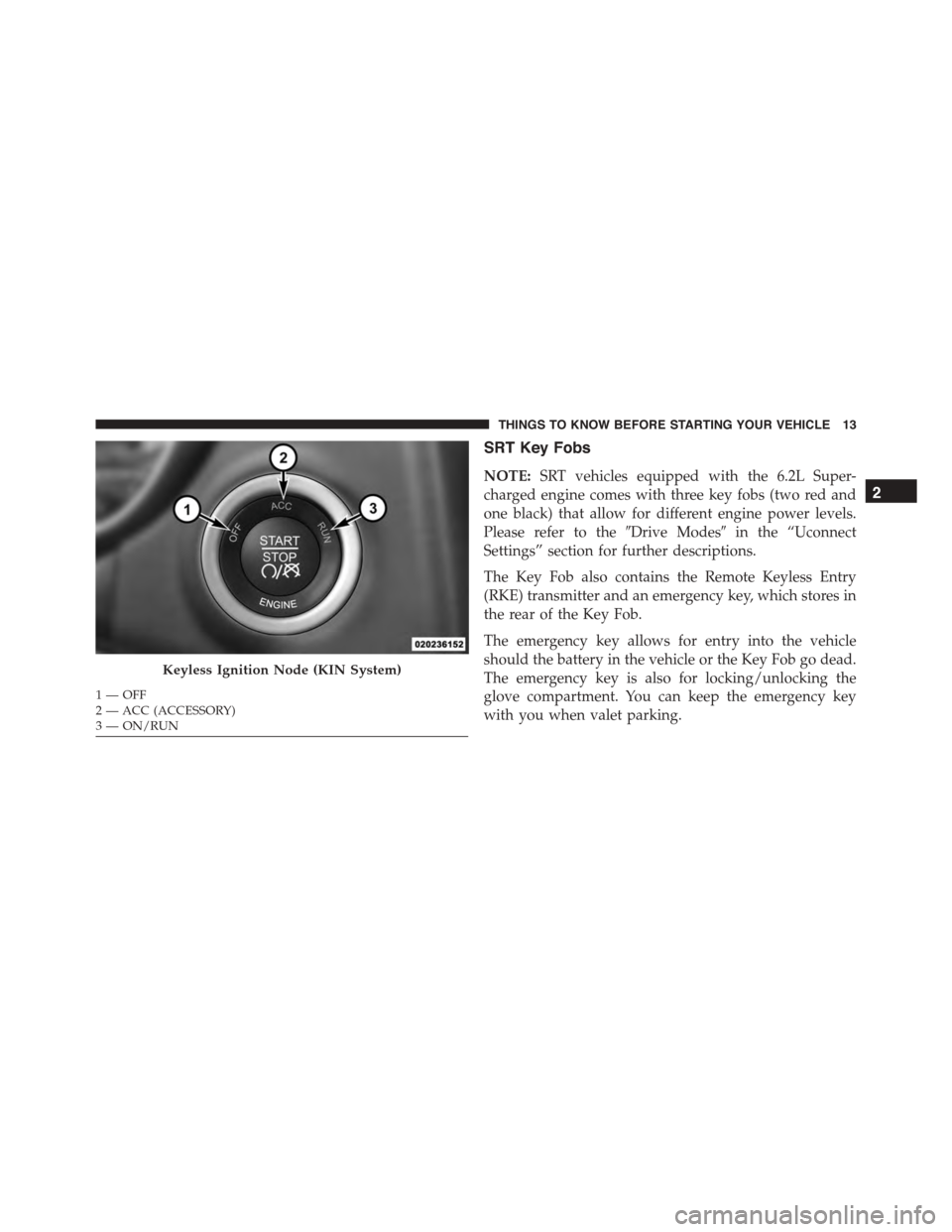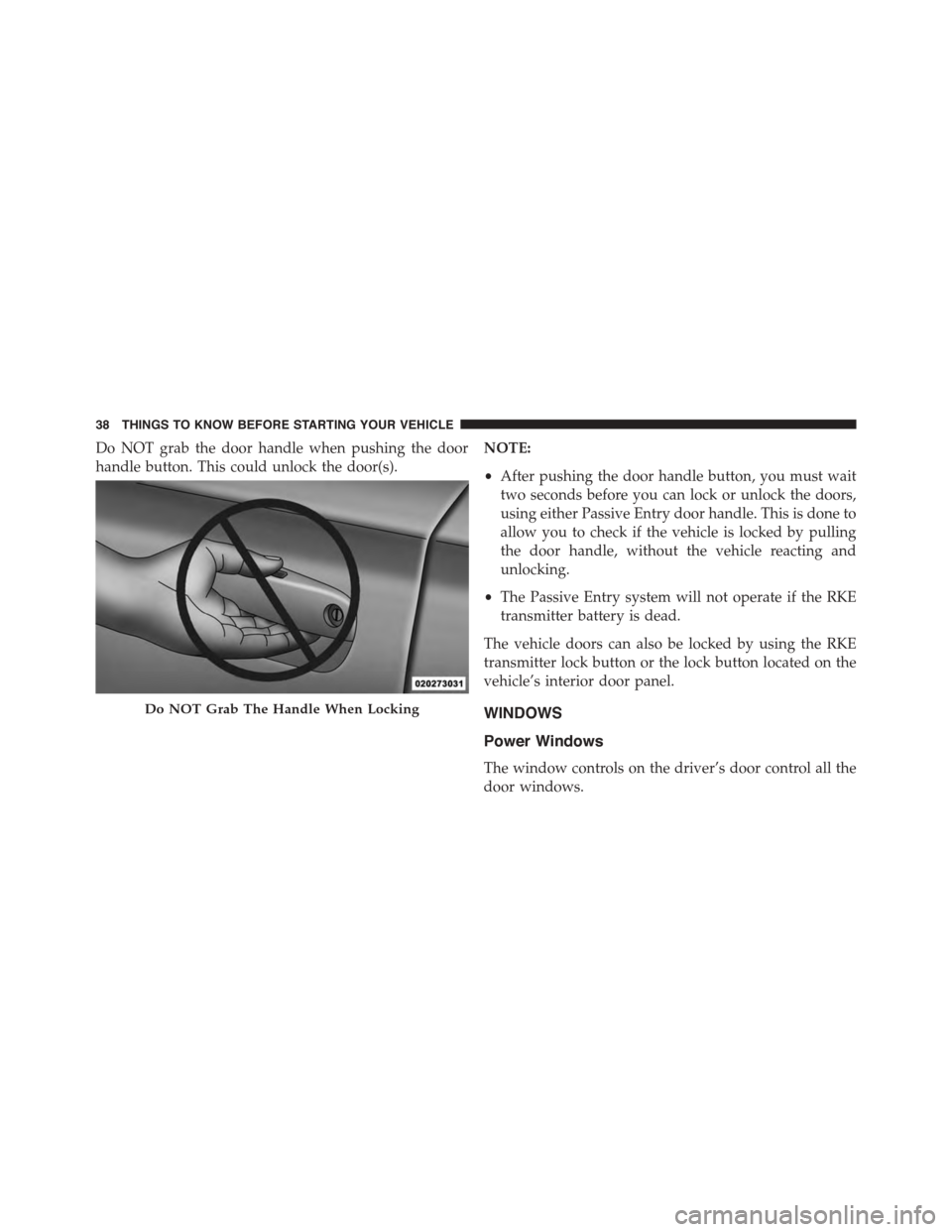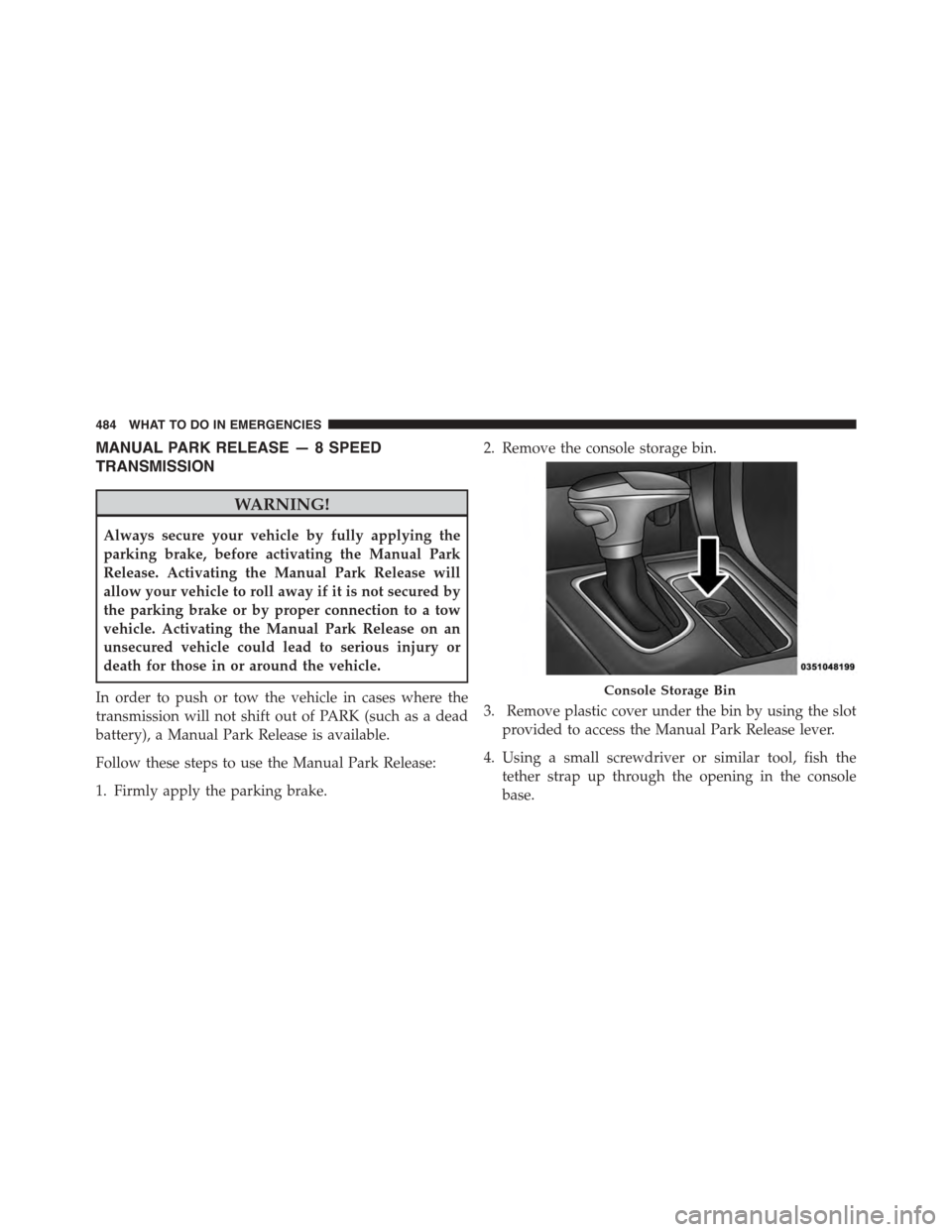dead battery DODGE CHARGER SRT 2015 7.G Owners Manual
[x] Cancel search | Manufacturer: DODGE, Model Year: 2015, Model line: CHARGER SRT, Model: DODGE CHARGER SRT 2015 7.GPages: 595, PDF Size: 16.43 MB
Page 14 of 595

A WORD ABOUT YOUR KEYS
Your vehicle uses a keyless ignition system. This system
consists of a Key Fob with Remote Keyless Entry (RKE)
transmitter and a Keyless Ignition Node (KIN).
Keyless Enter-N-Go™ Feature
This vehicle is equipped with the Keyless Enter-N-Go™
feature. Refer to#Keyless Enter-N-Go™#in#Things To
Know Before Starting Your Vehicle#for further informa-
tion.
Keyless Ignition Node (KIN)
This feature allows the driver to operate the ignition with
the push of a button as long as the Remote Keyless Entry
(RKE) transmitter is in the passenger compartment.
The Keyless Ignition Node (KIN System) has four oper-
ating positions, three of which are labeled and will
illuminate when in position. The three positions are: OFF,
ACC, and ON/RUN. The fourth position is START.
During start, ON/RUN will illuminate.
NOTE:In case the ignition does not change with the
push of a button, the RKE transmitter (Key Fob) may
have a low or dead battery. In this situation, a back up
method can be used to operate the ignition switch. Put
the nose side (side opposite of the emergency key) of the
Key Fob against the Engine START/STOP button and
push to operate the ignition.
12 THINGS TO KNOW BEFORE STARTING YOUR VEHICLE
Page 15 of 595

SRT Key Fobs
NOTE:SRT vehicles equipped with the 6.2L Super-
charged engine comes with three key fobs (two red and
one black) that allow for different engine power levels.
Please refer to the#Drive Modes#in the “Uconnect
Settings” section for further descriptions.
The Key Fob also contains the Remote Keyless Entry
(RKE) transmitter and an emergency key, which stores in
the rear of the Key Fob.
The emergency key allows for entry into the vehicle
should the battery in the vehicle or the Key Fob go dead.
The emergency key is also for locking/unlocking the
glove compartment. You can keep the emergency key
with you when valet parking.
Keyless Ignition Node (KIN System)
1—OFF2—ACC(ACCESSORY)3—ON/RUN
2
THINGS TO KNOW BEFORE STARTING YOUR VEHICLE 13
Page 40 of 595

Do NOT grab the door handle when pushing the door
handle button. This could unlock the door(s).
NOTE:
•After pushing the door handle button, you must wait
two seconds before you can lock or unlock the doors,
using either Passive Entry door handle. This is done to
allow you to check if the vehicle is locked by pulling
the door handle, without the vehicle reacting and
unlocking.
•The Passive Entry system will not operate if the RKE
transmitter battery is dead.
The vehicle doors can also be locked by using the RKE
transmitter lock button or the lock button located on the
vehicle’s interior door panel.
WINDOWS
Power Windows
The window controls on the driver’s door control all the
door windows.
Do NOT Grab The Handle When Locking
38 THINGS TO KNOW BEFORE STARTING YOUR VEHICLE
Page 486 of 595

MANUAL PARK RELEASE — 8 SPEED
TRANSMISSION
WARNING!
Always secure your vehicle by fully applying the
parking brake, before activating the Manual Park
Release. Activating the Manual Park Release will
allow your vehicle to roll away if it is not secured by
the parking brake or by proper connection to a tow
vehicle. Activating the Manual Park Release on an
unsecured vehicle could lead to serious injury or
death for those in or around the vehicle.
In order to push or tow the vehicle in cases where the
transmission will not shift out of PARK (such as a dead
battery), a Manual Park Release is available.
Follow these steps to use the Manual Park Release:
1. Firmly apply the parking brake.
2. Remove the console storage bin.
3. Remove plastic cover under the bin by using the slot
provided to access the Manual Park Release lever.
4. Using a small screwdriver or similar tool, fish the
tether strap up through the opening in the console
base.
Console Storage Bin
484 WHAT TO DO IN EMERGENCIES
Page 496 of 595

Indicator Light (MIL)” is functioning and is not on when
the engine is running, and that the OBD II system is
ready for testing.
Normally, the OBD II system will be ready. The OBD II
system maynotbe ready if your vehicle was recently
serviced, recently had a dead battery or a battery replace-
ment. If the OBD II system should be determined not
ready for the I/M test, your vehicle may fail the test.
Your vehicle has a simple ignition actuated test, which
you can use prior to going to the test station. To check if
your vehicle’s OBD II system is ready, you must do the
following:
1. Cycle the ignition switch to the ON position, but do
not crank or start the engine.
NOTE:If you crank or start the engine, you will have to
start this test over.
2. As soon as you cycle the ignition switch to the ON
position, you will see the Malfunction Indicator Light
(MIL) symbol come on as part of a normal bulb check.
3. Approximately 15 seconds later, one of two things will
happen:
•The MIL will flash for about 10 seconds and then
return to being fully illuminated until you turn OFF
the ignition or start the engine. This means that your
vehicle’s OBD II system isnot readyand you should
notproceed to the I/M station.
•The MIL will not flash at all and will remain fully
illuminated until you place the ignition in the off
position or start the engine. This means that your
vehicle’s OBD II system isreadyand you can proceed
to the I/M station.
If your OBD II system isnot ready,you should see your
authorized dealer or repair facility. If your vehicle was
494 MAINTAINING YOUR VEHICLE